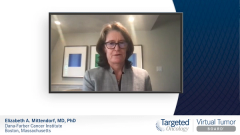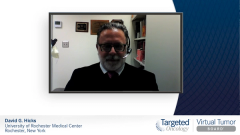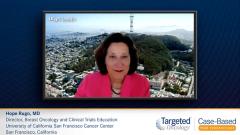
Case 3: Residual Disease in TNBC and Treatment Considerations
The panel of experts share their treatment recommendations for patients with residual disease after an incomplete response to TNBC therapy.
Episodes in this series

Elizabeth A. Mittendorf, MD, PhD: Ruta, I’m going off-script a little. This is another patient who had residual disease and who we gave capecitabine too. What criteria do you use to invoke the CREATE-X data to give these triple-negative patients with residual disease capecitabine? Is there a threshold, like any invasive disease? What do you guys use?
Ruta Rao, MD: It’s a discussion with the patient. In general, we offer it to anybody with any volume of residual disease. If a patient had 2 or 3 mm of residual disease in the breast tissue and nothing left in the lymph nodes, and they had started out with lymph node–positive disease, then they almost got pathologic complete response. I have had patients who aren’t interested at that point, and I don’t feel very strongly about giving it to them. I’ve seen other medical oncologists do the same, but in general, I don’t think we have a particular threshold.
We all get a little nervous about these triple-negative breast cancers and the risk of recurrence. The CREATE-X trial is the best data that we have right now, although there are other trials going on in this space. Some are even looking at immunotherapy for these patients who have residual triple-negative breast cancers. That’s something that may be changing at our institution. Participants in the SWOG trial—which looks at pembrolizumab in this setting—could have received capecitabine, and then they can get pembrolizumab if they have greater than 1 cm of residual tumor in the breast tissue or positive lymph nodes that are residual disease.
Elizabeth A. Mittendorf, MD, PhD: That’s a great point. Another hot space to be thinking about drug development is for those patients with residual disease. As David alluded to, if you have an RCB [residual cancer burden] score of 2 or 3, you have a pretty high recurrence rate just 2 years out. That SWOG trial you referred to, as you probably remember, was looking at pembrolizumab, but the investigators had to reconnoiter, for lack of a better description, once it was proven efficacious in this setting. They had to redesign their trial. This is a situation in which progress caused us to need to change a little. But my understanding is that the trial is either fully accredited or close to it.
Ruta Rao, MD: Very close, I believe.
Elizabeth A. Mittendorf, MD, PhD: Hopefully we’ll get some information about that. That’s a fascinating question. Immunotherapy seems to be beneficial in the metastatic setting. We didn’t discuss it tonight, but the IMpassion131 and KEYNOTE-522 studies showed that it does improve the pathologic complete response in the neoadjuvant setting. In both settings, the tumor was present. Antigen presentation relates to David’s description of how the immune system recognizes things. But in the adjuvant setting, that tumor is gone because you’ve given your preoperative chemotherapy, and I’ve excised it surgically. It will be interesting to see what we get.
Ruta Rao, MD: Because we’re really talking about micrometastatic disease.
Elizabeth A. Mittendorf, MD, PhD: I can see this from all sorts of different angles. If it’s a positive study, I’ll be able to explain it. If it’s a negative study, I’ll be able to explain it. But let’s stick with the immunotherapy related to this patient. David, I might have stumbled when I noted that in this 48-year-old with residual disease—now with chest wall and liver recurrence—we looked for PD-L1 using SP142, and the IC [information coefficient] score was greater than 1. But then I said, she went on to get carboplatin-gemcitabine and pembrolizumab. One might suggest that we’ve already beaten this issue. Just to resummarize, the companion diagnostic—if that’s what it’s being called for pembrolizumab—would actually have been the PD-L1 IHC [immunohistochemistry] 22C3 assay. The SP142 would have suggested that they might have been leaning toward giving atezolizumab. Repetition is never a bad thing. What would you suggest are the appropriate guidelines for the oncologist? I already hear you saying that they’re going to ask you to test for both, but what do you recommend?
David G. Hicks, MD: When they went back and looked at concordance between SP142 and 22C3, almost all the patients who were SP142-positive were also 22C3-positive. There was a tremendous overlap. There wasn’t an overlap for a significant number of patients who were positive for 22C3—and therefore eligible for pembrolizumab—but were negative for SP142. I would feel better about her getting pembrolizumab if she was SP142-positive. But we should be using the companion diagnostics, which were used in the clinical trial, to show efficacy.
Elizabeth A. Mittendorf, MD, PhD: Ruta, pulling this all together, we have a patient who’s progressed on immunotherapy. You went through the ASCENT data, and we’ve talked about maybe sending patients’ tumors to assess for somatic mutations. How would you treat this patient sitting in your office who has progressed 8 months after starting carboplatin-gemcitabine pembrolizumab?
Ruta Rao, MD: This is a patient who I would give sacituzumab govitecan to. Once in a while, in a situation like this, we run into insurance issues because it’s approved for patients who’ve got 2 or more lines of treatment in the metastatic setting. But this is a completely appropriate patient for sacituzumab. In the trial, we saw how superior it was to the other treatments we would have considered—eribulin, vinorelbine, gemcitabine, or capecitabine—which are the standard treatments we would use in a patient like this. If we couldn’t give sacituzumab, I would give 1 of those to this patient if she had capecitabine. Probably 1 of the intravenous choices, and then I would try to get sacituzumab as my next treatment option.
Elizabeth A. Mittendorf, MD, PhD: With respect to sacituzumab, let’s remind the audience that it’s an antibody-drug conjugate. Which means what?
Ruta Rao, MD: It means that it’s an antibody to the TROP2 and has the drug attached to it. The idea is kind of a Trojan horse. We’re very familiar now with antibody-drug conjugates in the HER2 [human epidermal growth factor receptor 2]–positive setting. It’s being used in the triple-negative setting. David, what about TROP2 expression in triple-negative breast cancers? Is this something seen in all breast cancers? Can you comment on TROP2 in this setting?
David G. Hicks, MD: It’s fairly ubiquitously expressed in breast cancer. They went back to the ASCENT trial and did a biomarker analysis in which they stain for TROP2, similar to how you would stain for HER2. Then they tried to do semi-quantitation using an H [histochemical] score. The amount of TROP2 didn’t predict much for benefit, and even those with very low levels of staining seemed to benefit. There was some correlation, but not enough that you would use it as a companion diagnostic. What that speaks to is how the antibody-drug conjugates are working. The TROP2 is really the hook that allows you to deliver the payload. It’s not so much that you need to block something, like in HER2, where you have to have a high level of expression. But if you have even lower levels of expression, you’re still able to get the antibody to bind and deliver the payload, and these payloads are diffusible. So there’s a bystander effect. It can kill adjacent cells. There is no companion diagnostic if you’re triple negative and, in the appropriate line of treatment, you’re a candidate.
Elizabeth A. Mittendorf, MD, PhD: Those data were presented at San Antonio Breast Cancer Symposium. My simple take on it is that you don’t have to have TROP2 expression to benefit from sacituzumab–I/O [immuno-oncology]. That’s how I took it. Ruta, what were your thoughts on those data?
Ruta Rao, MD: I agree. As David said, you don’t need to test for TROP2. This is approved for any patient with triple-negative breast cancer. The chemotherapy that’s bound to the antibody, in this case, is the active metabolite. It’s interesting because it’s not a drug we routinely use in breast cancer, but it seems to be very effective in this setting.
Elizabeth A. Mittendorf, MD, PhD: These antibody-drug conjugates are interesting. They demonstrate what both of you just observed: Drugs that may not be effective given systemically may work if targeted right to the tumor cells where they need to be. It’s similar for drugs that are far too toxic to give systemically. We see that with T-DM1 [trastuzumab emtansine]. You can’t give treatment without the pembrolizumab— taking it where you need to go.
Transcript edited for clarity.












































